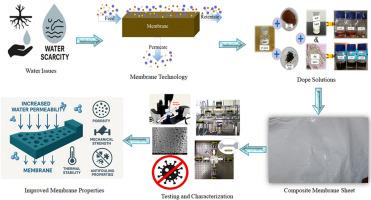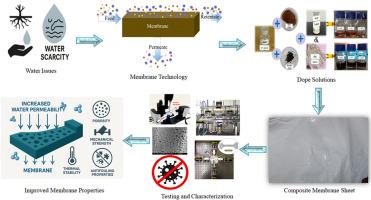Polysulfone membranes with natural additives for water purification: Fabrication and performance testing
IF 4.5
2区 化学
Q2 POLYMER SCIENCE
引用次数: 0
Abstract
The water scarcity is a leading problem all around the world. It occurs due to the increasing demand for clean water and depleting fresh water on earth. Water scarcity affects various aspects of human and animal life. The solution to reduce the burden on fresh water on earth is to purify the water available. Water purification leads to remove harmful contaminants from water and makes water useable for day-to-day human activities. The market of membrane technology is growing faster in this field. The main reason is less consumption of energy and scalability. The contaminant removal depends on the type of membranes and the pore size of membranes used. This study focuses on identifying appropriate materials for membranes and additives for cost-effective water filtration systems. Polysulfone (psf) beads are used as a base polymer, n-methyl-2-pyrrolidone (NMP), the solvent; and polyvinylpyrrolidone (PVP), the pore former. The additives used were date palm powder and banana leaf powder. Various compositions of dope solutions were prepared for each additive. The membranes were tested for water flux, thickness, hydrophilicity, pore size, porosity, antifouling capacity, and mechanical strength. The comparison showed that, the membrane with 0.15 %wt of banana leaf powder has given highest water permeability, porosity, antifouling capability, and mechanical strength. The pore size of these membranes is less than the most commonly found bacteria in water i.e. E. Coli. These membranes are also suitable for high pressure and temperature environmental conditions.


水净化用天然添加剂聚砜膜:制备及性能测试
水资源短缺是全世界的一个主要问题。它的发生是由于对清洁水的需求不断增加和地球上淡水的消耗。水资源短缺影响着人类和动物生活的各个方面。减轻地球上淡水负担的解决办法是净化可用的水。水净化可以去除水中的有害污染物,使水可用于日常的人类活动。膜技术在这一领域的市场发展较快。主要原因是更少的能源消耗和可扩展性。污染物的去除取决于膜的类型和所用膜的孔径。本研究的重点是为具有成本效益的水过滤系统确定合适的膜和添加剂材料。聚砜(psf)珠用作基础聚合物,n-甲基-2-吡咯烷酮(NMP)为溶剂;聚乙烯吡咯烷酮(PVP)为孔隙形成剂。添加剂为枣棕榈粉和香蕉叶粉。为每种添加剂制备了不同组成的涂料溶液。测试了膜的水通量、厚度、亲水性、孔径、孔隙率、防污能力和机械强度。结果表明,香蕉叶粉添加量为0.15%时,膜的透水性、孔隙率、防污性能和机械强度最高。这些膜的孔径小于水中最常见的细菌,即大肠杆菌。这些膜也适用于高压和高温环境条件。
本文章由计算机程序翻译,如有差异,请以英文原文为准。
求助全文
约1分钟内获得全文
求助全文
来源期刊

Polymer
化学-高分子科学
CiteScore
7.90
自引率
8.70%
发文量
959
审稿时长
32 days
期刊介绍:
Polymer is an interdisciplinary journal dedicated to publishing innovative and significant advances in Polymer Physics, Chemistry and Technology. We welcome submissions on polymer hybrids, nanocomposites, characterisation and self-assembly. Polymer also publishes work on the technological application of polymers in energy and optoelectronics.
The main scope is covered but not limited to the following core areas:
Polymer Materials
Nanocomposites and hybrid nanomaterials
Polymer blends, films, fibres, networks and porous materials
Physical Characterization
Characterisation, modelling and simulation* of molecular and materials properties in bulk, solution, and thin films
Polymer Engineering
Advanced multiscale processing methods
Polymer Synthesis, Modification and Self-assembly
Including designer polymer architectures, mechanisms and kinetics, and supramolecular polymerization
Technological Applications
Polymers for energy generation and storage
Polymer membranes for separation technology
Polymers for opto- and microelectronics.
 求助内容:
求助内容: 应助结果提醒方式:
应助结果提醒方式:


